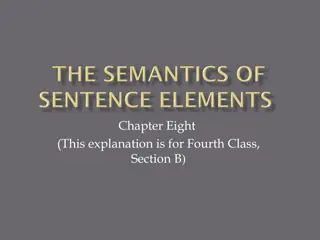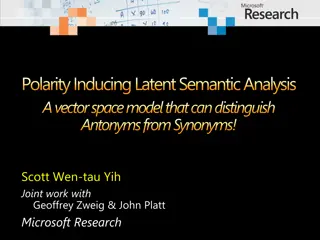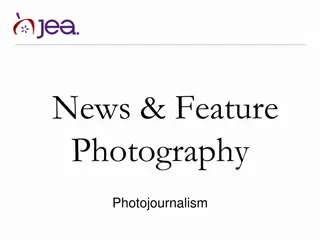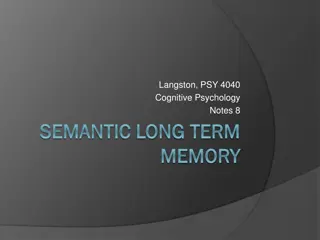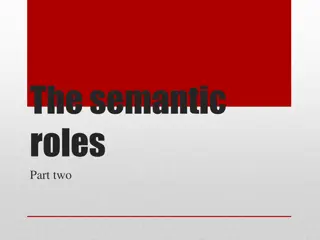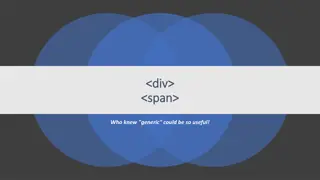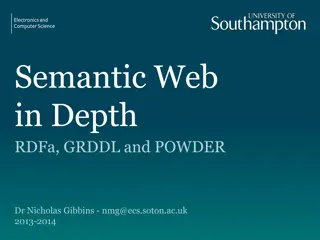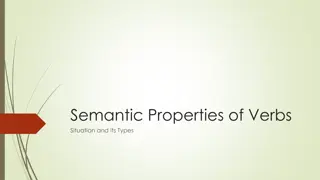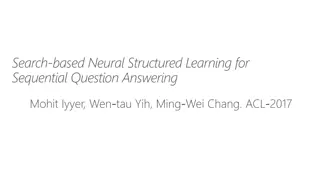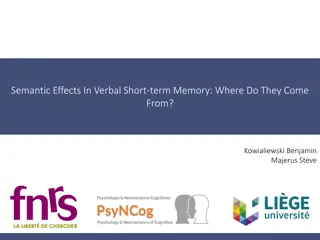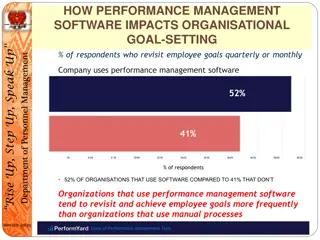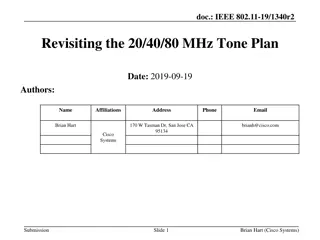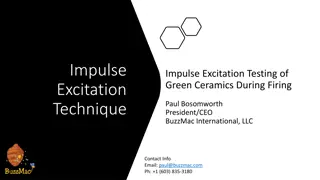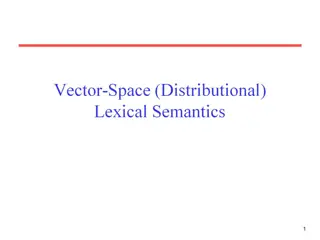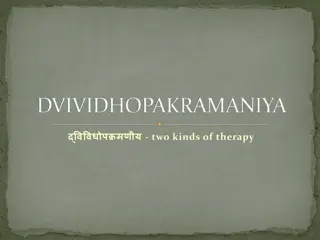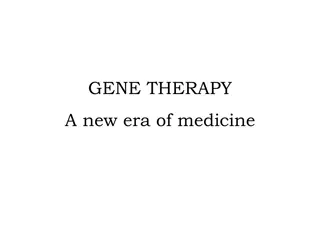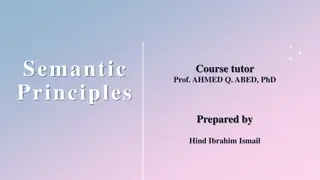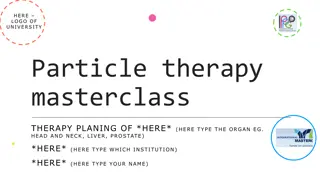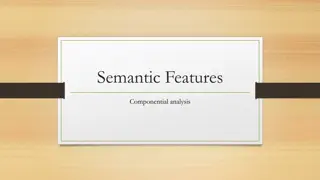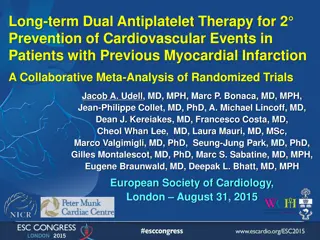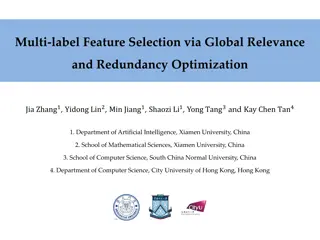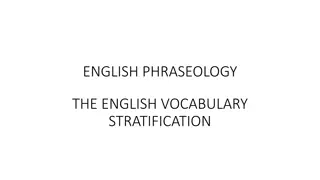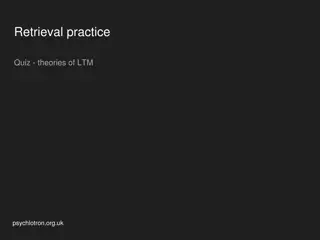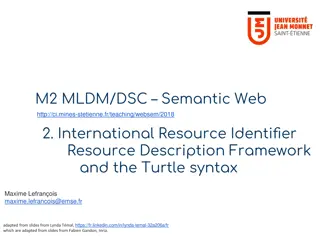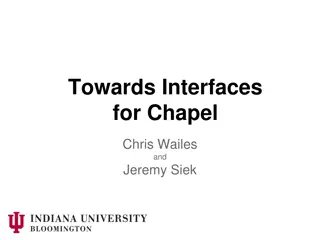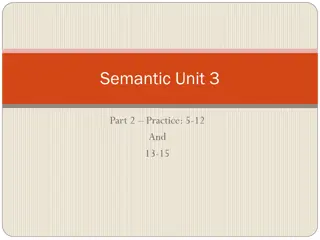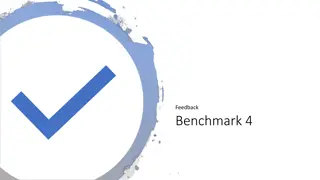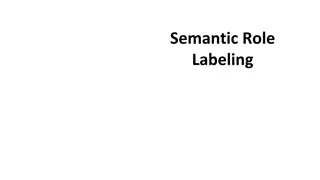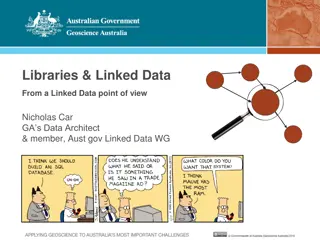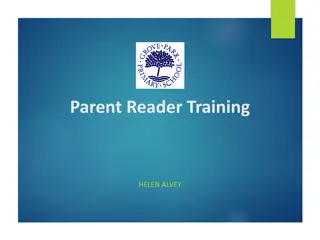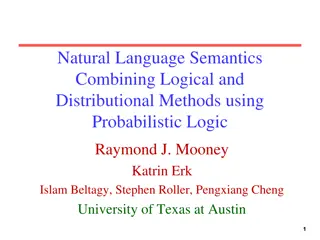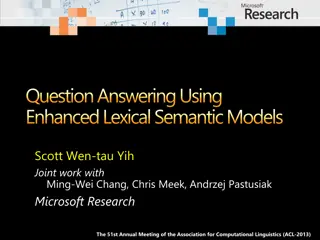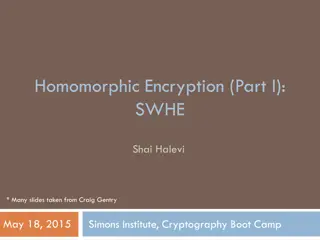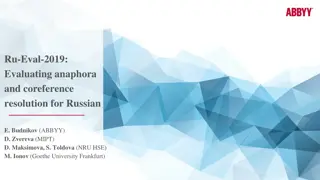Revisiting Semantic Feature Analysis: A Classic Therapy Technique
Aphasia often involves semantic breakdown, and Semantic Feature Analysis (SFA) is a foundational technique for various treatments addressing semantic impairments. This presentation explores the effectiveness of SFA in improving naming, generalization to spontaneous speech, and treatment goals beyond word level to discourse-based objectives. The group's research involved article searching, experimental design, and the absence of correlation between treatment efficacy and various aphasia factors.
Download Presentation

Please find below an Image/Link to download the presentation.
The content on the website is provided AS IS for your information and personal use only. It may not be sold, licensed, or shared on other websites without obtaining consent from the author. Download presentation by click this link. If you encounter any issues during the download, it is possible that the publisher has removed the file from their server.
E N D
Presentation Transcript
What's new for semantic feature analysis? Revisiting a classic therapy technique Linda Jones, Julia Murphy and Claire Layfield (Group Co-Leaders) LyndseyNickels -Academic Member Presented by Claire Layfield
Aphasia is frequently associated with semantic breakdown Semantic feature analysis is a technique that underpins the general philosophy behind many treatments for semantic impairments
Semantic word Object, picture or idea retrieval impairment Semantics 4-legs pet fur barks purrs scales Phonological Lexicon dog rabbit fish house robin cat Phonological Buffer/ Phonemes k d o g t Slide modified with thanks to Lyndsey Nickels
GROUP ACTION PROPERTIES ASSOCIATION (Boyle, 2001; Boyle, 2004; Coelho, McHugh, & Boyle, 2004; Kiran, & Johnson,2008; Kiran, 2008; Rider, Wright, Marshall & Page, 2008)
Semantic feature analysis therapy is provided at word level BUT our treatment goals are discourse based Clinical Question: For people with aphasia, in what circumstances does SFA improve Naming of treated items Naming of untreated items Generalisation to spontaneous speech
Initial searching by the group found 23 articles From these 16 were CAPPED The others were excluded because Treatment data was not available (e.g. expert commentary) Treatment was not applicable (e.g. neuroimaging) The participants had speech and language impairments in addition to aphasia
Research design Single case experimental design Case series Low level of evidence on NHMRC evidence hierarchy. BUT well designed single case and case series, can be more powerful in terms of clinical applicability.
No correlation between treatment efficacy and Type of aphasia Severity of aphasia Time post onset Aetiology Representative of the group caseload
Variability noted in Treatment schedules Therapy duration Individual vs group based Variability noted in therapy administration Cueing hierarchies, prompts, responses to errors Added components of discourse (put word into phrase)
Measures included confrontational naming (typically treated and untreated items) Standardised measures Generalisation measures typically discourse based (CIU, words and error production rates) Participation measures: Social validity questionnaire
Treated items increased and maintained Untreated items Similar trends but reduced in magnitude Standardised assessments Small improvements to overall scores Generalisation At best modest improvements in discourse based measurements maintained over time
Semantic feature analysis Appears to be clinically feasible Increases naming, reduces perseveration, and this transfers to conversation in the short term What remains in question is Is this technique more beneficial than other therapy techniques and Is there a way of combining this technique with a second level of phrase/sentence level therapy which may generate and maintain functional communication improvements
Research investigating Semantic feature analysis vs other techniques which is controlled for therapy dosage Semantic feature analysis in group vs individual settings Systematic investigation of enhancing maintenance and generalisation Outcomes from acute and chronic phases of therapy would all be helpful to determine the extent and nature of the therapy benefits reported in the literature to date
Target = Ruby Barks in the middle of the night Digs holes in new lawn Jumps to get clean clothes off the line Best Friend Steals shoes and chews them
Antonucci, S. M. (2009). Use of semantic feature analysis in group aphasia treatment. Aphasiology, 23(7-8), 854-866. Boyle, M. (2001). Semantic Feature Analysis: The Evidence for Treating Lexical Impairments in Aphasia. . Perspectives on Neurophysiology and Neurogenic Speech and Language Disorders, 11, 23-28. Boyle, M. (2004). Semantic feature analysis treatment for anomia in two fluent aphasia syndromes. American Journal of Speech-Language Pathology, 13(3), 236-249. Boyle, M. (2010). Semantic feature analysis treatment for aphasic word retrieval impairments: What's in a name? Topics in Stroke Rehabilitation, 17(6), 411-422. Boyle, M. (2011). Discourse treatment for word retrieval impairment in aphasia: The story so far. Aphasiology, 25(11), 1308-1326. Boyle, M., & Coelho, C. A. (1995). Application of Semantic Feature Analysis as a Treatment for Aphasic Dysnomia. American Journal of Speech-Language Pathology, 4(4), 94-98. Cermak, L. S., Stiassny, D., & Uhly, B. (1984). Reconstructive Retrieval Deficits in Broca's Aphasia. Brain and Language, 21(1), 95-104. Coelho, C. A., McHugh, R. E., & Boyle, M. (2000). Semantic feature analysis as a treatment for aphasic dysnomia: A replication. Aphasiology, 14(2), 133-142. Conley, A., & Coelho, C. A. (2003). Treatment of word retrieval impairment in chronic Broca's aphasia. Aphasiology, 17(3), 203-211. Davis, L. A., & Stanton, S. T. (2005). Semantic feature analysis as a functional therapy tool. Contemporary Issues in Communication Science & Disorders, 32, 85-92. Falconer, C., & Antonucci, S. M. (2012). Use of semantic feature analysis in group discourse treatment for aphasia: Extension and expansion. Aphasiology, 26(1), 64-82. Hashimoto, N., & Frome, A. (2011). The use of a modified semantic features analysis approach in aphasia. Journal of Communication Disorders, 44(4), 459-469. Kiran, S., Ntourou, K., Eubanks, M., & Shamapant, S. (2005). Typicality of inanimate category exemplars in aphasia: Further evidence for the semantic complexity effect. Brain and Language, 95(1 SPEC. ISS.), 178-180. Kiran, S., & Roberts, P. M. (2010). Semantic feature analysis treatment in spanish-english and french-english bilingual aphasia. Aphasiology, 24(2), 231-261.
Kiran, S., & Viswanathan, M. (2008). Effect of model-based treatment on oral reading abilities in severe alexia: a case study. Journal of Medical Speech-Language Pathology, 16(1), 43-59. Law, S.-P., Wong, W., Sung, F., & Hon, J. (2006). A study of semantic treatment of three Chinese anomic patients. Neuropsychological Rehabilitation, 16(6), 601-629. Law, S. P., Yeung, O., & Chiu, K. M. Y. (2008). Treatment for anomia in Chinese using an ortho-phonological cueing method. Aphasiology, 22(2), 139-163. Leonard, C., Rochon, E., & Laird, L. (2008). Treating naming impairments in aphasia: Findings from a phonological components analysis treatment. Aphasiology, 22(9), 923-947. Lowell, S., Beeson, P. M., & Holland, A. L. (1995). The Efficacy of a Semantic Cueing Procedure on Naming Performance of Adults with Aphasia. American Journal of Speech-Language Pathology, 4(4), 109-114. Marcotte, K., & Ansaldo, A. I. (2010). The neural correlates of semantic feature analysis in chronic aphasia: discordant patterns according to the etiology. Seminars in speech and language, 31(1), 52-63. Marcotte, K., Damien, B., De Preaumont, M., Genereux, S., Hubert, M., & Ansaldo, A. (2010). Neural correlates of semantic feature analysis in chronic aphasia: A multiple single-case study. Stroke, 41(7), e499. Marcotte, K., Vitali, P., Delgado, A. P., & Ansaldo, A. I. (2006). The neural correlates of therapy with semantic feature analysis in chronic anomia: an event-related fMRI study... 44th Annual Meeting of the Academy of Aphasia, Victoria, British Columbia 15th-17th October 2006. Brain & Language, 99(1-2), 206-207. Peach, R. K., & Reuter, K. A. (2010). A discourse-based approach to semantic feature analysis for the treatment of aphasic word retrieval failures. Aphasiology, 24(9), 971-990. Rider, J. D., Wright, H. H., Marshall, R. C., & Page, J. L. (2008). Using semantic feature analysis to improve contextual discourse in adults with aphasia. American Journal of Speech-Language Pathology, 17(2), 161-172. Rose, M., & Douglas, J. (2008). Treating a semantic word production deficit in aphasia with verbal and gesture methods. Aphasiology, 22(1), 20-41. Viswanathan, M., & Kiran, S. (2005). Treatment for pure alexia using a model based approach: Evidence from one acute aphasic individual. Brain and Language, 95(1 SPEC. ISS.), 204-206. Wambaugh, J. L., & Ferguson, M. (2007). Application of semantic feature analysis to retrieval of action names in aphasia. Journal of Rehabilitation Research and Development, 44(3), 381-394



